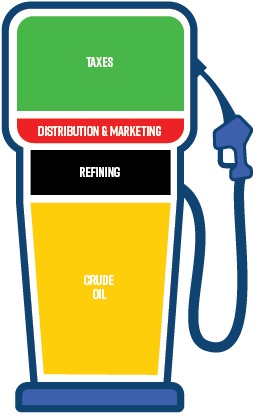Why No Comment
The story behind the story of pump price commentary
On any given day, somewhere in Canada the price of gasoline is making headlines. From Victoria to Saint John’s, Canadian consumers see or hear media coverage about pump prices and their gyrations, and explanations and related commentary. They want answers and journalists do their best to write informative material.
Here at the Canadian Fuels Association we are often called upon by the media to explain what’s behind pump prices, whether it’s sustained record high prices in Vancouver, a 7 cent per litre price increase at the station around the corner, or why prices are consistently different in Sudbury and North Bay.
More often than not, callers are disappointed, even frustrated by our inability to give detailed responses, and by our recommendations that they contact independent market analysts for more details. The result is that sometimes, readers encounter statements in the media such as “the Canadian Fuels Association refused to comment” or “when contacted, we were passed-off to an analyst”. The story behind these statements can vary. It’s true that we might not provide comment or we might refer journalists to other resources, but when asked about pump prices in particular, the reason why we do this isn’t often passed-along to readers.
There’s one good reason why our responses are confined to general statements about how competitive fuel markets work and the factors that influence prices and price movements. It’s against the law for us to do otherwise!
The Competition Act
“The purpose of the Act is to maintain and encourage competition in Canada in order to promote the efficiency and adaptability of the Canadian economy, in order to expand opportunities for Canadian participation in world markets while at the same time recognizing the role of foreign competition in Canada, in order to ensure that small and medium-sized enterprises have an equitable opportunity to participate in the Canadian economy and in order to provide consumers with competitive prices and product.”
The Competition Act, section 1.1:
The Purpose of the Act. R.S.C., 1985, c. C-34
Pump price components

As an association of competitors, we take our responsibilities under Canada’s Competition Act very seriously.
The Competition Act makes it a criminal offence for competitors to fix prices, allocate markets, or restrict output. We take extraordinary measures to ensure that nothing we do at the Association could be remotely construed as anticompetitive behaviour under the Competition Act. We don’t talk about competitive factors such as price components, production levels and inventories, market or customer allocations. And we don’t discuss what members might or might not do in response to proposed government policy or decisions; in particular, the effect such policies or decisions could have on prices.
We do know that market dynamics are just that, they’re dynamic and driven by the fundamental economic concepts of supply and demand. Gasoline is a commodity that trades freely on North American commodity markets—it’s an integrated North American market for refined products. Four components make up the price consumers pay at the pump—crude cost, refining margin, retail mark up and taxes. Within this basic framework, and at any given time, a host of factors are at work influencing pump prices. These factors can be global, national, regional, even local. They range from geopolitical instability in a far corner of the world, to seasonal changes in gasoline demand, to an unplanned refinery outage, to a local retailer changing her price in an effort to grow market share.
Whatever the combination of factors, the variability in gasoline prices is actually a testament to the dynamic nature of fuel as a globally traded commodity, and confirms a competitive free-market at work.
